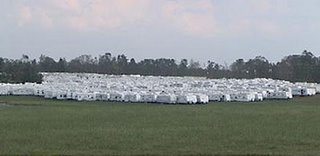From 'Happy Meal' to 'BattleBox'

[Image: Disinfotainment Today]
To accommodate Rummy's McArmy – 'a more nimble and cost-effective fighting force that could be deployed in multiple hot spots around the globe' – the public-private portfolio of the Pentagon's defense investments had to be packaged inside a newly-improved duraflex prefab military architecture.

[Image: Yo Joe]
From the 'Happy Meal' to the 'BattleBox,' those little toy soldiers still came pouring out as the U.S. military went modular.

[Image: The BattleBox's Toy Prize]

[Image: Think IN the BattleBox]

[Images: here & here]
Somewhere between an inflatable and converted old bunker, McDonald's deployed its BattleBoxes as far as Afghanistan, paving over 200,000 sq mi of 'pure American asphalt.'

[Image: Stop! McDonald's]
Also, according to this site, 'McDonald's is the second largest owner of real estate in the world surpassed only by the Vatican City.'
In sprawling barracks like these, the Pentagon has taken full advantage of the affordability and nimble assembly/disassembly of the prefab revolution, while huge contracting companies like Comark, Williams Scotsman, and GE Modular cash in on the Rise of Disaster Capitalism, or the blood of the so-called 'Disaster-Industrial-Complex' which feeds the war machine for its own existence.

[Image: Engineer Update]
While BRAC calculates the costs of reshifting the Baseworld Archipelago, closing bases in one location only to erect them in another, the architectural translation of this 'Rumsfeldian' strategy couldn't be more obvious.

[Image: Think IN the BattleBox]

[Image: Think IN the BattleBox]

[Image: Refugee Container Housing / 'Future Shack': Sean Godsell]
Indeed, this flexible architecture has equally profitable applications in the war-torn landscapes of the third world. But how are we to design temporary and transitional structures that, in reality, end up becoming permanent and wrecklessly institutional?
Soldiers, mercenaries, UN aid workers, NGO's and journalists all permanently reside in the same housing shells that litter refugee camps in Afghanistan and Iraq. We see so many of the world's disaster zones dug-in with shelter types that are reduced to a mere surface foam of idle 'mobile intervention.' Here, on opposite sides of conflict, both worlds mimic each other as architectural pawns on the military chess board of globalization's tactical real-estate war.

[Image: BagNewNotes]
These settlements are not altogether different from the trailer park ghettos that have become more and more permanent each day for the Katrina hurricane evacuees in the States; nor are they fundamentally different from the alarming increase of mobile home parks housing the nation's poor at large.
In a permanent state of impermanence, or, rather a ubiquitous squatt, Military Urbanism both sustains and is sustained by a stasis of perpetual conflict. As Naomi Klein discussed in The Nation earlier this year, the U.S. State Dept. created the 'Office of the Coordinator for Reconstruction and Stabilization,' devoted to pre-emptive nation building. Klein writes: 'Gone are the days of waiting for wars to break out and then drawing up ad hoc plans to pick up the pieces. In close cooperation with the National Intelligence Council, this office keeps "high risk" countries on a "watch list" and assembles rapid-response teams ready to engage in prewar planning and to "mobilize and deploy quickly" after a conflict has gone down. The teams are made up of private companies, nongovernmental organizations and members of think tanks – some will have "pre-completed" contracts to rebuild countries that are not yet broken.'

[Image: TRADOC: 'Modular Army Barracks']
These barracks look more like a caravan of Hollywood trailers loaded to the brim with girls and costumes, beers and props, extra generators and sweet little backdrops, lights, cameras, guns, drugs and action with a lot of smoke and mirrors. The military may as well be making their own Blockbuster War flicks these days.
But this modularized architectural landscape now insinuates itself, in a backlash, within U.S. domestic housing policy, where affordable housing has become a marketplace far too exclusive for the average American family (though prefab might have more to say about that in the future). A new majority of the American population lives in military flux, housed in what may as well be run-down Hollywood mobiles for making war movies abroad.
But instead of using prefab to help drive policy reform – Dallas, for instance, actually banned some prefab last year from being used for certain affordable housing – we get a disposable new universal housing typology for the masses which continues to emerge from socio-political landscapes across the map, creeping towards something crossed between a modular holding cell, a beat down trailer park, or some heavily surveilled government assistance shelter, either strung out in a brownfield somewhere, an urban ghetto, a bombed out city, a sunken or drained city, a shrinking city, a temporary and instant one in the middle of the desert flocking with floating populations dislocated completely from their national citizenship or access to political amnesty. Are we witnessing a Third Worldization of the western nations as the slipping First World economy struggles to hold on to its power by force? If architecture is any indication, what will become of these discarded shells or the people left to inhabit them?
"We're just Extras, man, We're ALL, just, Extras!"

[Image: Photos-of-the-Year: by Grover]







0 Comments:
Post a Comment
<< Home